NATIONAL SAFETY & QUALITY HEALTH SERVICE
VerifiedAdded on 2022/08/12
|10
|2635
|34
AI Summary
1. There are eight National Safety & Quality Health Service (NSQHS) Standards developed by the Australian Commission on Safety and Quality in Health Care in 2018. Choose three (3) of these Standards and discuss how they relate to nursing. Your discussion should explain why it is essential that nurses are aware of the quality and safety frameworks that govern nursing practice.
Contribute Materials
Your contribution can guide someone’s learning journey. Share your
documents today.
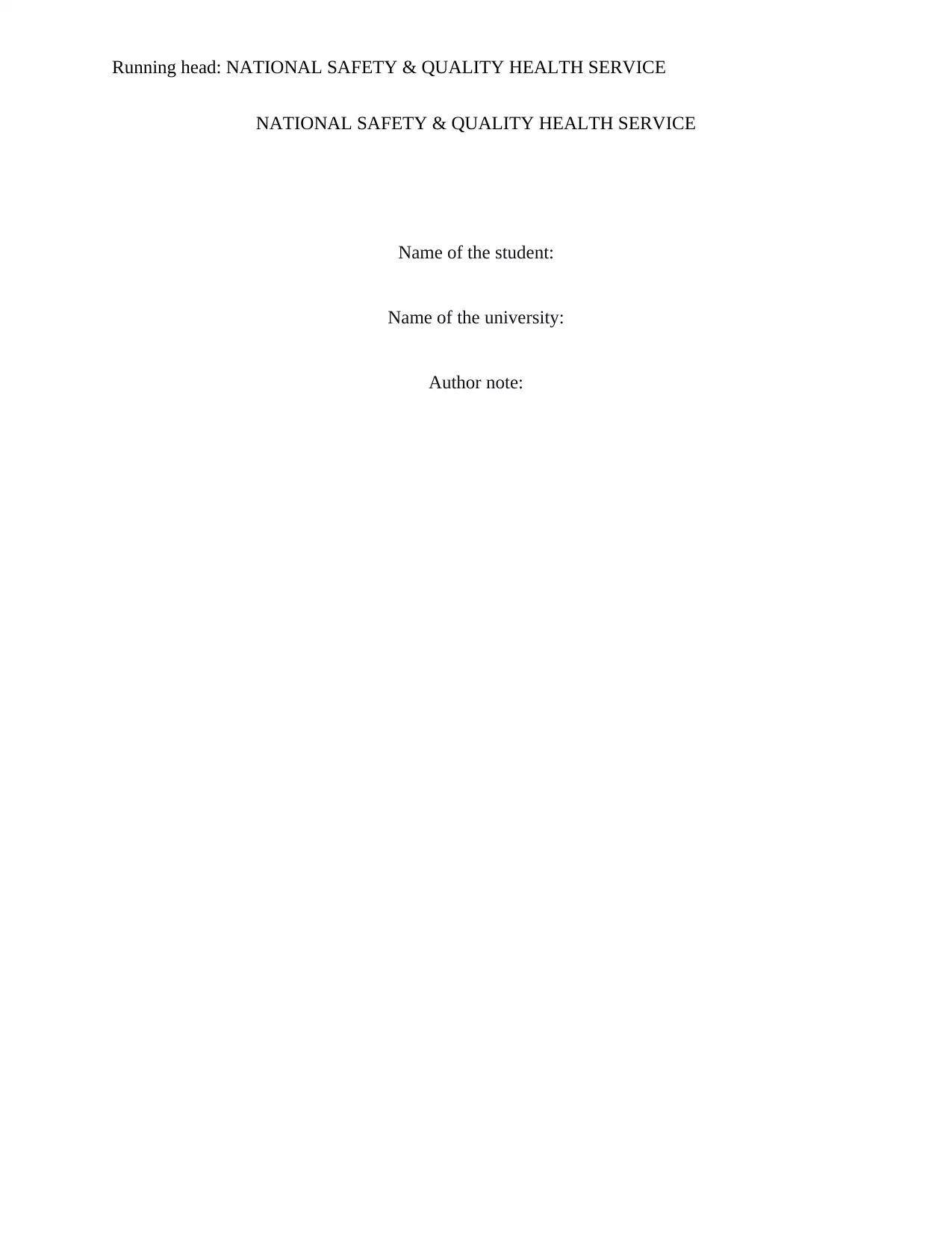
Running head: NATIONAL SAFETY & QUALITY HEALTH SERVICE
NATIONAL SAFETY & QUALITY HEALTH SERVICE
Name of the student:
Name of the university:
Author note:
NATIONAL SAFETY & QUALITY HEALTH SERVICE
Name of the student:
Name of the university:
Author note:
Secure Best Marks with AI Grader
Need help grading? Try our AI Grader for instant feedback on your assignments.
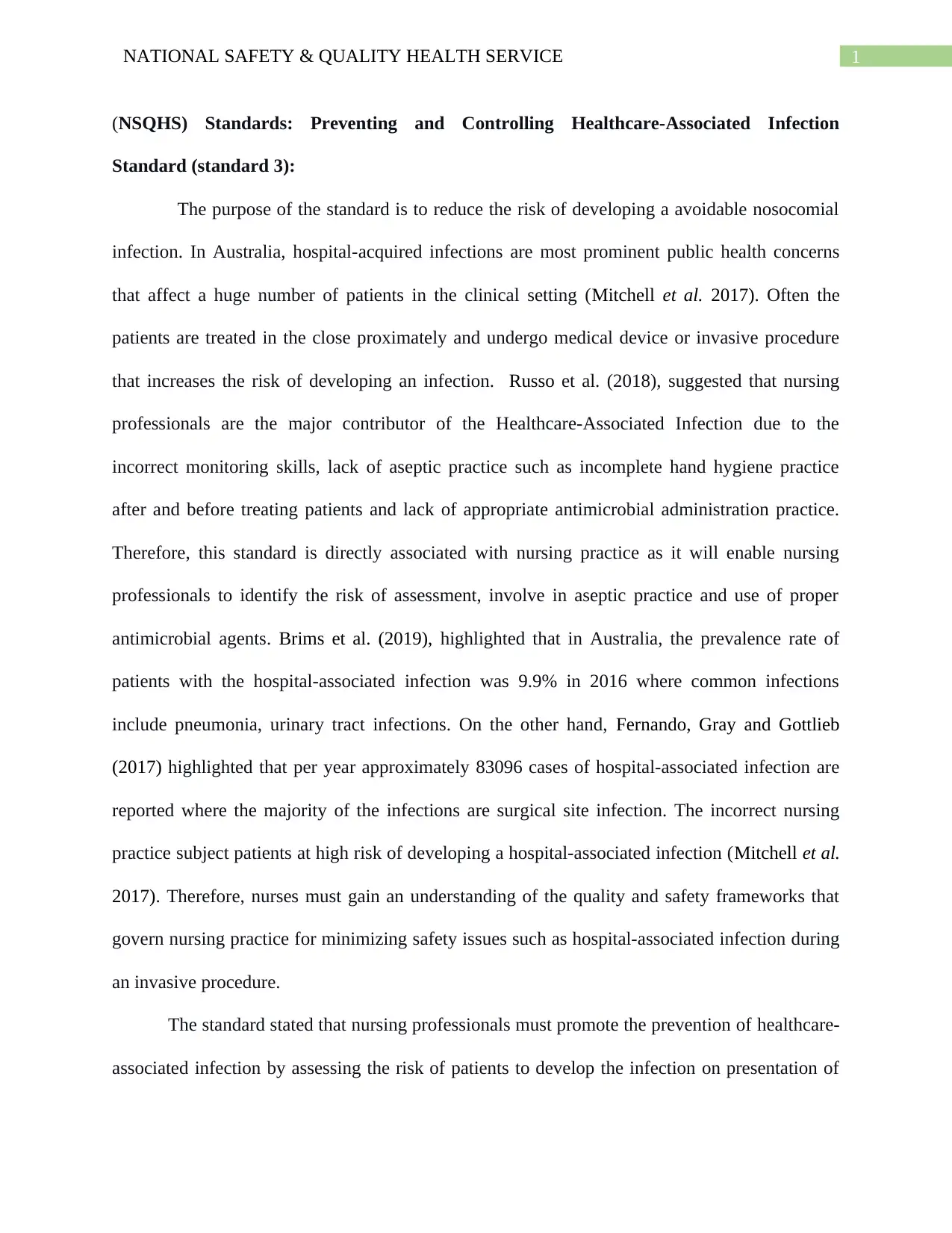
1NATIONAL SAFETY & QUALITY HEALTH SERVICE
(NSQHS) Standards: Preventing and Controlling Healthcare-Associated Infection
Standard (standard 3):
The purpose of the standard is to reduce the risk of developing a avoidable nosocomial
infection. In Australia, hospital-acquired infections are most prominent public health concerns
that affect a huge number of patients in the clinical setting (Mitchell et al. 2017). Often the
patients are treated in the close proximately and undergo medical device or invasive procedure
that increases the risk of developing an infection. Russo et al. (2018), suggested that nursing
professionals are the major contributor of the Healthcare-Associated Infection due to the
incorrect monitoring skills, lack of aseptic practice such as incomplete hand hygiene practice
after and before treating patients and lack of appropriate antimicrobial administration practice.
Therefore, this standard is directly associated with nursing practice as it will enable nursing
professionals to identify the risk of assessment, involve in aseptic practice and use of proper
antimicrobial agents. Brims et al. (2019), highlighted that in Australia, the prevalence rate of
patients with the hospital-associated infection was 9.9% in 2016 where common infections
include pneumonia, urinary tract infections. On the other hand, Fernando, Gray and Gottlieb
(2017) highlighted that per year approximately 83096 cases of hospital-associated infection are
reported where the majority of the infections are surgical site infection. The incorrect nursing
practice subject patients at high risk of developing a hospital-associated infection (Mitchell et al.
2017). Therefore, nurses must gain an understanding of the quality and safety frameworks that
govern nursing practice for minimizing safety issues such as hospital-associated infection during
an invasive procedure.
The standard stated that nursing professionals must promote the prevention of healthcare-
associated infection by assessing the risk of patients to develop the infection on presentation of
(NSQHS) Standards: Preventing and Controlling Healthcare-Associated Infection
Standard (standard 3):
The purpose of the standard is to reduce the risk of developing a avoidable nosocomial
infection. In Australia, hospital-acquired infections are most prominent public health concerns
that affect a huge number of patients in the clinical setting (Mitchell et al. 2017). Often the
patients are treated in the close proximately and undergo medical device or invasive procedure
that increases the risk of developing an infection. Russo et al. (2018), suggested that nursing
professionals are the major contributor of the Healthcare-Associated Infection due to the
incorrect monitoring skills, lack of aseptic practice such as incomplete hand hygiene practice
after and before treating patients and lack of appropriate antimicrobial administration practice.
Therefore, this standard is directly associated with nursing practice as it will enable nursing
professionals to identify the risk of assessment, involve in aseptic practice and use of proper
antimicrobial agents. Brims et al. (2019), highlighted that in Australia, the prevalence rate of
patients with the hospital-associated infection was 9.9% in 2016 where common infections
include pneumonia, urinary tract infections. On the other hand, Fernando, Gray and Gottlieb
(2017) highlighted that per year approximately 83096 cases of hospital-associated infection are
reported where the majority of the infections are surgical site infection. The incorrect nursing
practice subject patients at high risk of developing a hospital-associated infection (Mitchell et al.
2017). Therefore, nurses must gain an understanding of the quality and safety frameworks that
govern nursing practice for minimizing safety issues such as hospital-associated infection during
an invasive procedure.
The standard stated that nursing professionals must promote the prevention of healthcare-
associated infection by assessing the risk of patients to develop the infection on presentation of
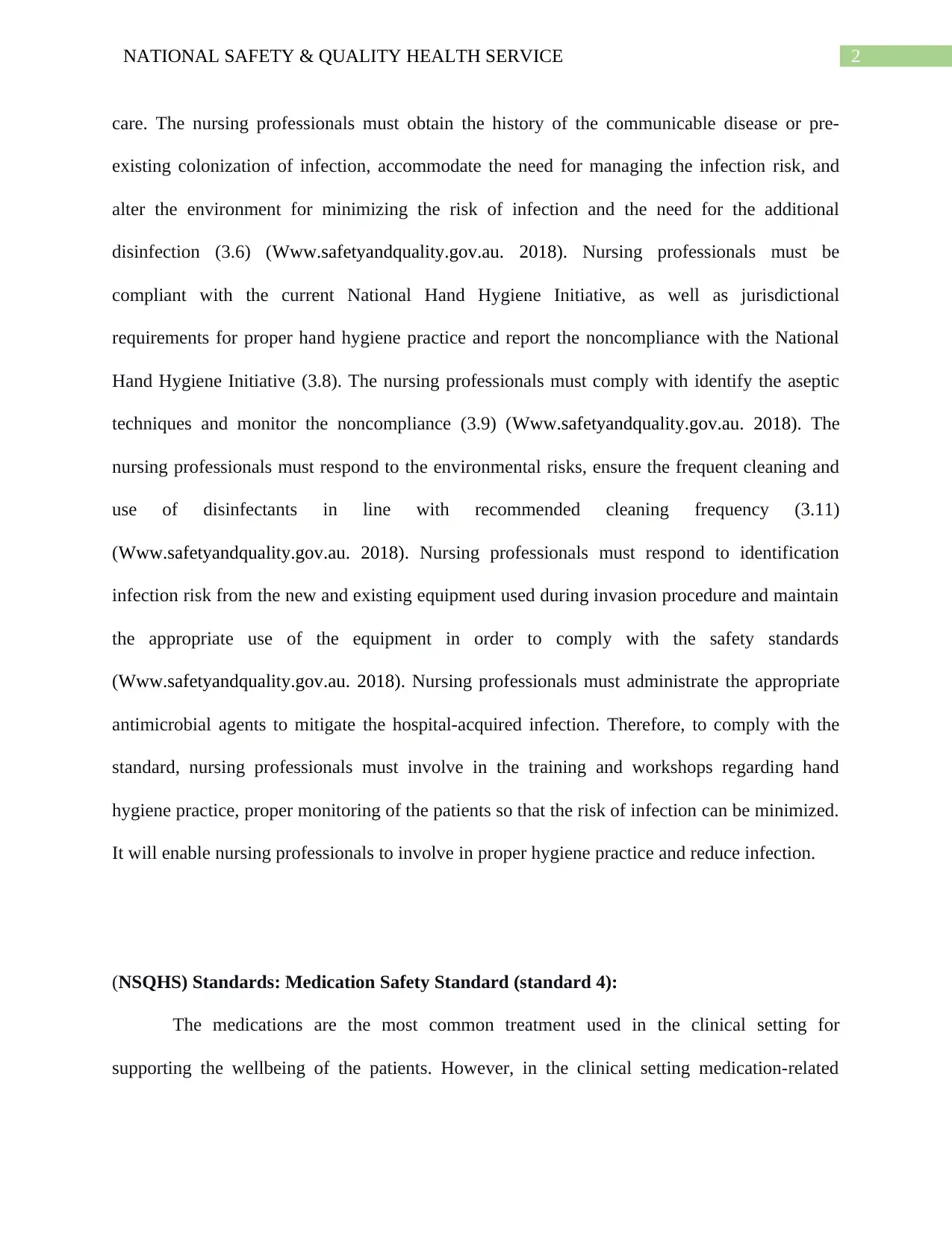
2NATIONAL SAFETY & QUALITY HEALTH SERVICE
care. The nursing professionals must obtain the history of the communicable disease or pre-
existing colonization of infection, accommodate the need for managing the infection risk, and
alter the environment for minimizing the risk of infection and the need for the additional
disinfection (3.6) (Www.safetyandquality.gov.au. 2018). Nursing professionals must be
compliant with the current National Hand Hygiene Initiative, as well as jurisdictional
requirements for proper hand hygiene practice and report the noncompliance with the National
Hand Hygiene Initiative (3.8). The nursing professionals must comply with identify the aseptic
techniques and monitor the noncompliance (3.9) (Www.safetyandquality.gov.au. 2018). The
nursing professionals must respond to the environmental risks, ensure the frequent cleaning and
use of disinfectants in line with recommended cleaning frequency (3.11)
(Www.safetyandquality.gov.au. 2018). Nursing professionals must respond to identification
infection risk from the new and existing equipment used during invasion procedure and maintain
the appropriate use of the equipment in order to comply with the safety standards
(Www.safetyandquality.gov.au. 2018). Nursing professionals must administrate the appropriate
antimicrobial agents to mitigate the hospital-acquired infection. Therefore, to comply with the
standard, nursing professionals must involve in the training and workshops regarding hand
hygiene practice, proper monitoring of the patients so that the risk of infection can be minimized.
It will enable nursing professionals to involve in proper hygiene practice and reduce infection.
(NSQHS) Standards: Medication Safety Standard (standard 4):
The medications are the most common treatment used in the clinical setting for
supporting the wellbeing of the patients. However, in the clinical setting medication-related
care. The nursing professionals must obtain the history of the communicable disease or pre-
existing colonization of infection, accommodate the need for managing the infection risk, and
alter the environment for minimizing the risk of infection and the need for the additional
disinfection (3.6) (Www.safetyandquality.gov.au. 2018). Nursing professionals must be
compliant with the current National Hand Hygiene Initiative, as well as jurisdictional
requirements for proper hand hygiene practice and report the noncompliance with the National
Hand Hygiene Initiative (3.8). The nursing professionals must comply with identify the aseptic
techniques and monitor the noncompliance (3.9) (Www.safetyandquality.gov.au. 2018). The
nursing professionals must respond to the environmental risks, ensure the frequent cleaning and
use of disinfectants in line with recommended cleaning frequency (3.11)
(Www.safetyandquality.gov.au. 2018). Nursing professionals must respond to identification
infection risk from the new and existing equipment used during invasion procedure and maintain
the appropriate use of the equipment in order to comply with the safety standards
(Www.safetyandquality.gov.au. 2018). Nursing professionals must administrate the appropriate
antimicrobial agents to mitigate the hospital-acquired infection. Therefore, to comply with the
standard, nursing professionals must involve in the training and workshops regarding hand
hygiene practice, proper monitoring of the patients so that the risk of infection can be minimized.
It will enable nursing professionals to involve in proper hygiene practice and reduce infection.
(NSQHS) Standards: Medication Safety Standard (standard 4):
The medications are the most common treatment used in the clinical setting for
supporting the wellbeing of the patients. However, in the clinical setting medication-related
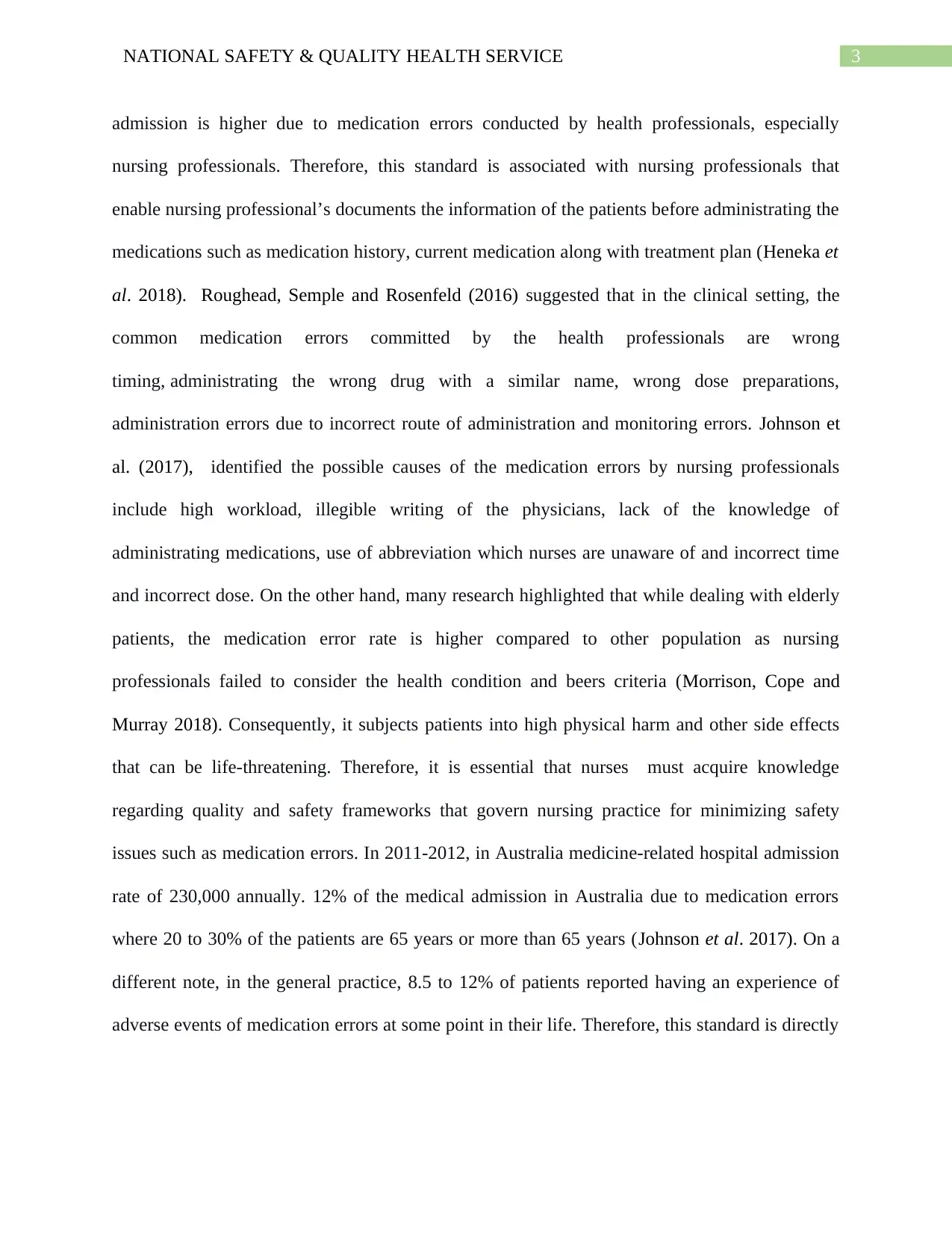
3NATIONAL SAFETY & QUALITY HEALTH SERVICE
admission is higher due to medication errors conducted by health professionals, especially
nursing professionals. Therefore, this standard is associated with nursing professionals that
enable nursing professional’s documents the information of the patients before administrating the
medications such as medication history, current medication along with treatment plan (Heneka et
al. 2018). Roughead, Semple and Rosenfeld (2016) suggested that in the clinical setting, the
common medication errors committed by the health professionals are wrong
timing, administrating the wrong drug with a similar name, wrong dose preparations,
administration errors due to incorrect route of administration and monitoring errors. Johnson et
al. (2017), identified the possible causes of the medication errors by nursing professionals
include high workload, illegible writing of the physicians, lack of the knowledge of
administrating medications, use of abbreviation which nurses are unaware of and incorrect time
and incorrect dose. On the other hand, many research highlighted that while dealing with elderly
patients, the medication error rate is higher compared to other population as nursing
professionals failed to consider the health condition and beers criteria (Morrison, Cope and
Murray 2018). Consequently, it subjects patients into high physical harm and other side effects
that can be life-threatening. Therefore, it is essential that nurses must acquire knowledge
regarding quality and safety frameworks that govern nursing practice for minimizing safety
issues such as medication errors. In 2011-2012, in Australia medicine-related hospital admission
rate of 230,000 annually. 12% of the medical admission in Australia due to medication errors
where 20 to 30% of the patients are 65 years or more than 65 years (Johnson et al. 2017). On a
different note, in the general practice, 8.5 to 12% of patients reported having an experience of
adverse events of medication errors at some point in their life. Therefore, this standard is directly
admission is higher due to medication errors conducted by health professionals, especially
nursing professionals. Therefore, this standard is associated with nursing professionals that
enable nursing professional’s documents the information of the patients before administrating the
medications such as medication history, current medication along with treatment plan (Heneka et
al. 2018). Roughead, Semple and Rosenfeld (2016) suggested that in the clinical setting, the
common medication errors committed by the health professionals are wrong
timing, administrating the wrong drug with a similar name, wrong dose preparations,
administration errors due to incorrect route of administration and monitoring errors. Johnson et
al. (2017), identified the possible causes of the medication errors by nursing professionals
include high workload, illegible writing of the physicians, lack of the knowledge of
administrating medications, use of abbreviation which nurses are unaware of and incorrect time
and incorrect dose. On the other hand, many research highlighted that while dealing with elderly
patients, the medication error rate is higher compared to other population as nursing
professionals failed to consider the health condition and beers criteria (Morrison, Cope and
Murray 2018). Consequently, it subjects patients into high physical harm and other side effects
that can be life-threatening. Therefore, it is essential that nurses must acquire knowledge
regarding quality and safety frameworks that govern nursing practice for minimizing safety
issues such as medication errors. In 2011-2012, in Australia medicine-related hospital admission
rate of 230,000 annually. 12% of the medical admission in Australia due to medication errors
where 20 to 30% of the patients are 65 years or more than 65 years (Johnson et al. 2017). On a
different note, in the general practice, 8.5 to 12% of patients reported having an experience of
adverse events of medication errors at some point in their life. Therefore, this standard is directly
Secure Best Marks with AI Grader
Need help grading? Try our AI Grader for instant feedback on your assignments.
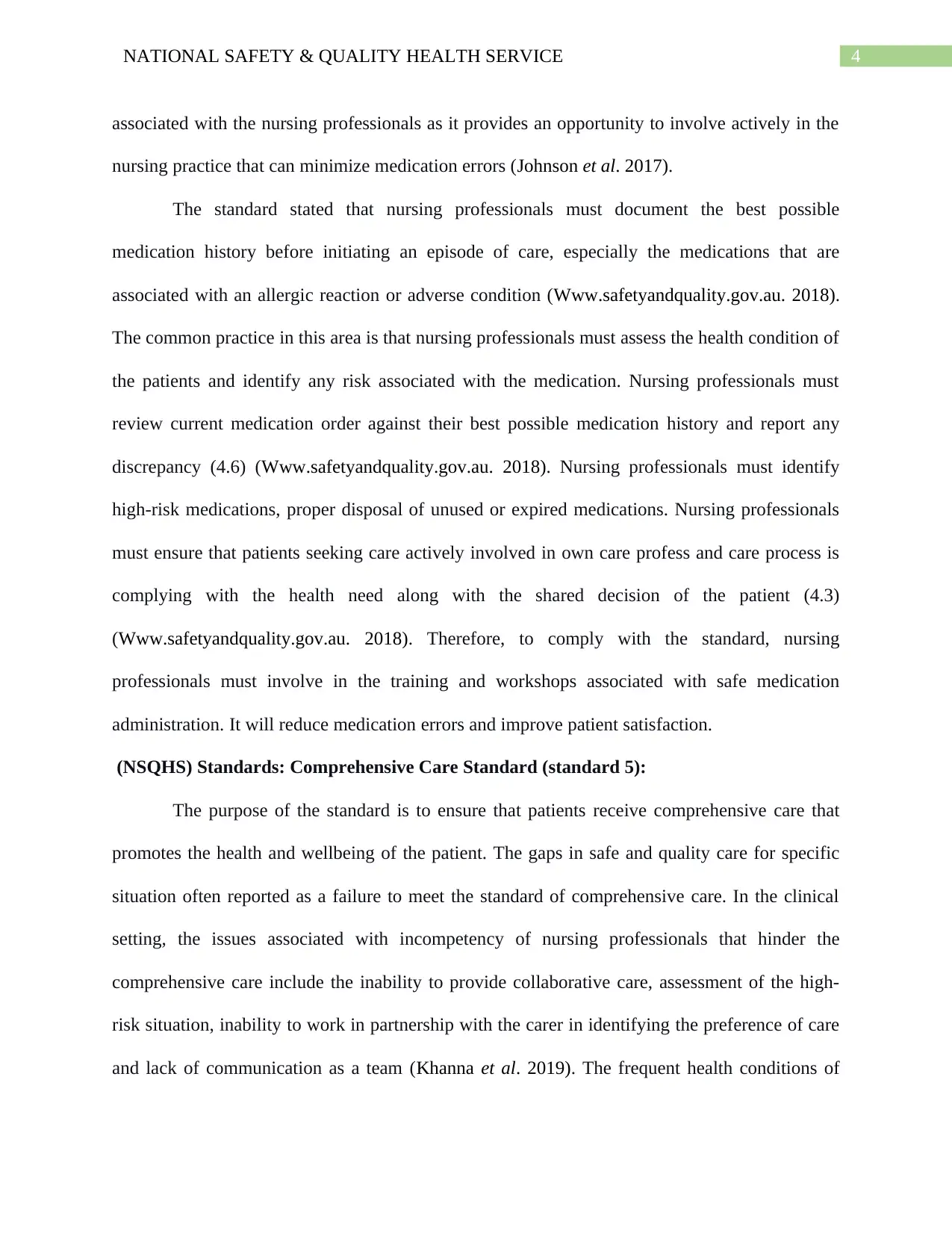
4NATIONAL SAFETY & QUALITY HEALTH SERVICE
associated with the nursing professionals as it provides an opportunity to involve actively in the
nursing practice that can minimize medication errors (Johnson et al. 2017).
The standard stated that nursing professionals must document the best possible
medication history before initiating an episode of care, especially the medications that are
associated with an allergic reaction or adverse condition (Www.safetyandquality.gov.au. 2018).
The common practice in this area is that nursing professionals must assess the health condition of
the patients and identify any risk associated with the medication. Nursing professionals must
review current medication order against their best possible medication history and report any
discrepancy (4.6) (Www.safetyandquality.gov.au. 2018). Nursing professionals must identify
high-risk medications, proper disposal of unused or expired medications. Nursing professionals
must ensure that patients seeking care actively involved in own care profess and care process is
complying with the health need along with the shared decision of the patient (4.3)
(Www.safetyandquality.gov.au. 2018). Therefore, to comply with the standard, nursing
professionals must involve in the training and workshops associated with safe medication
administration. It will reduce medication errors and improve patient satisfaction.
(NSQHS) Standards: Comprehensive Care Standard (standard 5):
The purpose of the standard is to ensure that patients receive comprehensive care that
promotes the health and wellbeing of the patient. The gaps in safe and quality care for specific
situation often reported as a failure to meet the standard of comprehensive care. In the clinical
setting, the issues associated with incompetency of nursing professionals that hinder the
comprehensive care include the inability to provide collaborative care, assessment of the high-
risk situation, inability to work in partnership with the carer in identifying the preference of care
and lack of communication as a team (Khanna et al. 2019). The frequent health conditions of
associated with the nursing professionals as it provides an opportunity to involve actively in the
nursing practice that can minimize medication errors (Johnson et al. 2017).
The standard stated that nursing professionals must document the best possible
medication history before initiating an episode of care, especially the medications that are
associated with an allergic reaction or adverse condition (Www.safetyandquality.gov.au. 2018).
The common practice in this area is that nursing professionals must assess the health condition of
the patients and identify any risk associated with the medication. Nursing professionals must
review current medication order against their best possible medication history and report any
discrepancy (4.6) (Www.safetyandquality.gov.au. 2018). Nursing professionals must identify
high-risk medications, proper disposal of unused or expired medications. Nursing professionals
must ensure that patients seeking care actively involved in own care profess and care process is
complying with the health need along with the shared decision of the patient (4.3)
(Www.safetyandquality.gov.au. 2018). Therefore, to comply with the standard, nursing
professionals must involve in the training and workshops associated with safe medication
administration. It will reduce medication errors and improve patient satisfaction.
(NSQHS) Standards: Comprehensive Care Standard (standard 5):
The purpose of the standard is to ensure that patients receive comprehensive care that
promotes the health and wellbeing of the patient. The gaps in safe and quality care for specific
situation often reported as a failure to meet the standard of comprehensive care. In the clinical
setting, the issues associated with incompetency of nursing professionals that hinder the
comprehensive care include the inability to provide collaborative care, assessment of the high-
risk situation, inability to work in partnership with the carer in identifying the preference of care
and lack of communication as a team (Khanna et al. 2019). The frequent health conditions of
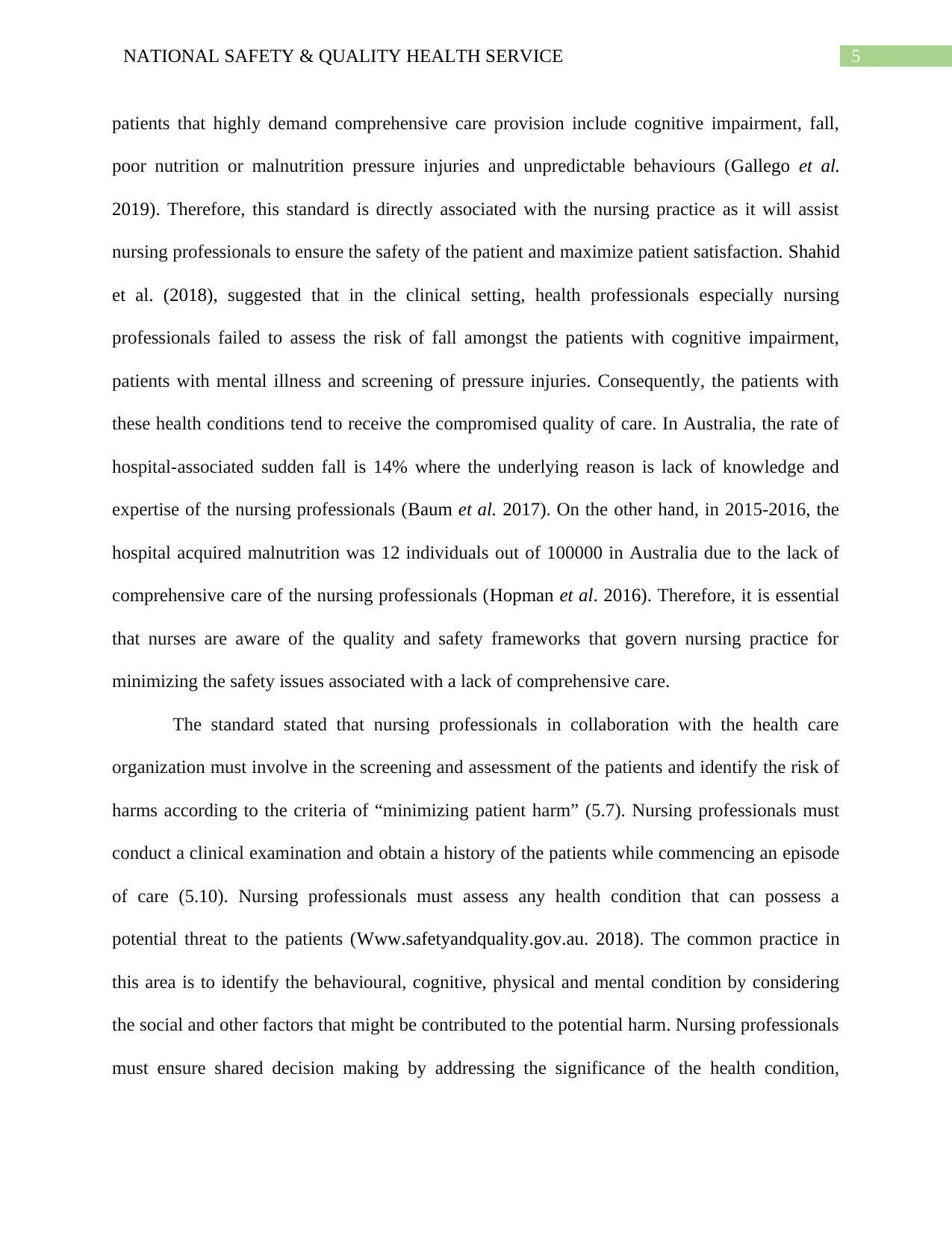
5NATIONAL SAFETY & QUALITY HEALTH SERVICE
patients that highly demand comprehensive care provision include cognitive impairment, fall,
poor nutrition or malnutrition pressure injuries and unpredictable behaviours (Gallego et al.
2019). Therefore, this standard is directly associated with the nursing practice as it will assist
nursing professionals to ensure the safety of the patient and maximize patient satisfaction. Shahid
et al. (2018), suggested that in the clinical setting, health professionals especially nursing
professionals failed to assess the risk of fall amongst the patients with cognitive impairment,
patients with mental illness and screening of pressure injuries. Consequently, the patients with
these health conditions tend to receive the compromised quality of care. In Australia, the rate of
hospital-associated sudden fall is 14% where the underlying reason is lack of knowledge and
expertise of the nursing professionals (Baum et al. 2017). On the other hand, in 2015-2016, the
hospital acquired malnutrition was 12 individuals out of 100000 in Australia due to the lack of
comprehensive care of the nursing professionals (Hopman et al. 2016). Therefore, it is essential
that nurses are aware of the quality and safety frameworks that govern nursing practice for
minimizing the safety issues associated with a lack of comprehensive care.
The standard stated that nursing professionals in collaboration with the health care
organization must involve in the screening and assessment of the patients and identify the risk of
harms according to the criteria of “minimizing patient harm” (5.7). Nursing professionals must
conduct a clinical examination and obtain a history of the patients while commencing an episode
of care (5.10). Nursing professionals must assess any health condition that can possess a
potential threat to the patients (Www.safetyandquality.gov.au. 2018). The common practice in
this area is to identify the behavioural, cognitive, physical and mental condition by considering
the social and other factors that might be contributed to the potential harm. Nursing professionals
must ensure shared decision making by addressing the significance of the health condition,
patients that highly demand comprehensive care provision include cognitive impairment, fall,
poor nutrition or malnutrition pressure injuries and unpredictable behaviours (Gallego et al.
2019). Therefore, this standard is directly associated with the nursing practice as it will assist
nursing professionals to ensure the safety of the patient and maximize patient satisfaction. Shahid
et al. (2018), suggested that in the clinical setting, health professionals especially nursing
professionals failed to assess the risk of fall amongst the patients with cognitive impairment,
patients with mental illness and screening of pressure injuries. Consequently, the patients with
these health conditions tend to receive the compromised quality of care. In Australia, the rate of
hospital-associated sudden fall is 14% where the underlying reason is lack of knowledge and
expertise of the nursing professionals (Baum et al. 2017). On the other hand, in 2015-2016, the
hospital acquired malnutrition was 12 individuals out of 100000 in Australia due to the lack of
comprehensive care of the nursing professionals (Hopman et al. 2016). Therefore, it is essential
that nurses are aware of the quality and safety frameworks that govern nursing practice for
minimizing the safety issues associated with a lack of comprehensive care.
The standard stated that nursing professionals in collaboration with the health care
organization must involve in the screening and assessment of the patients and identify the risk of
harms according to the criteria of “minimizing patient harm” (5.7). Nursing professionals must
conduct a clinical examination and obtain a history of the patients while commencing an episode
of care (5.10). Nursing professionals must assess any health condition that can possess a
potential threat to the patients (Www.safetyandquality.gov.au. 2018). The common practice in
this area is to identify the behavioural, cognitive, physical and mental condition by considering
the social and other factors that might be contributed to the potential harm. Nursing professionals
must ensure shared decision making by addressing the significance of the health condition,
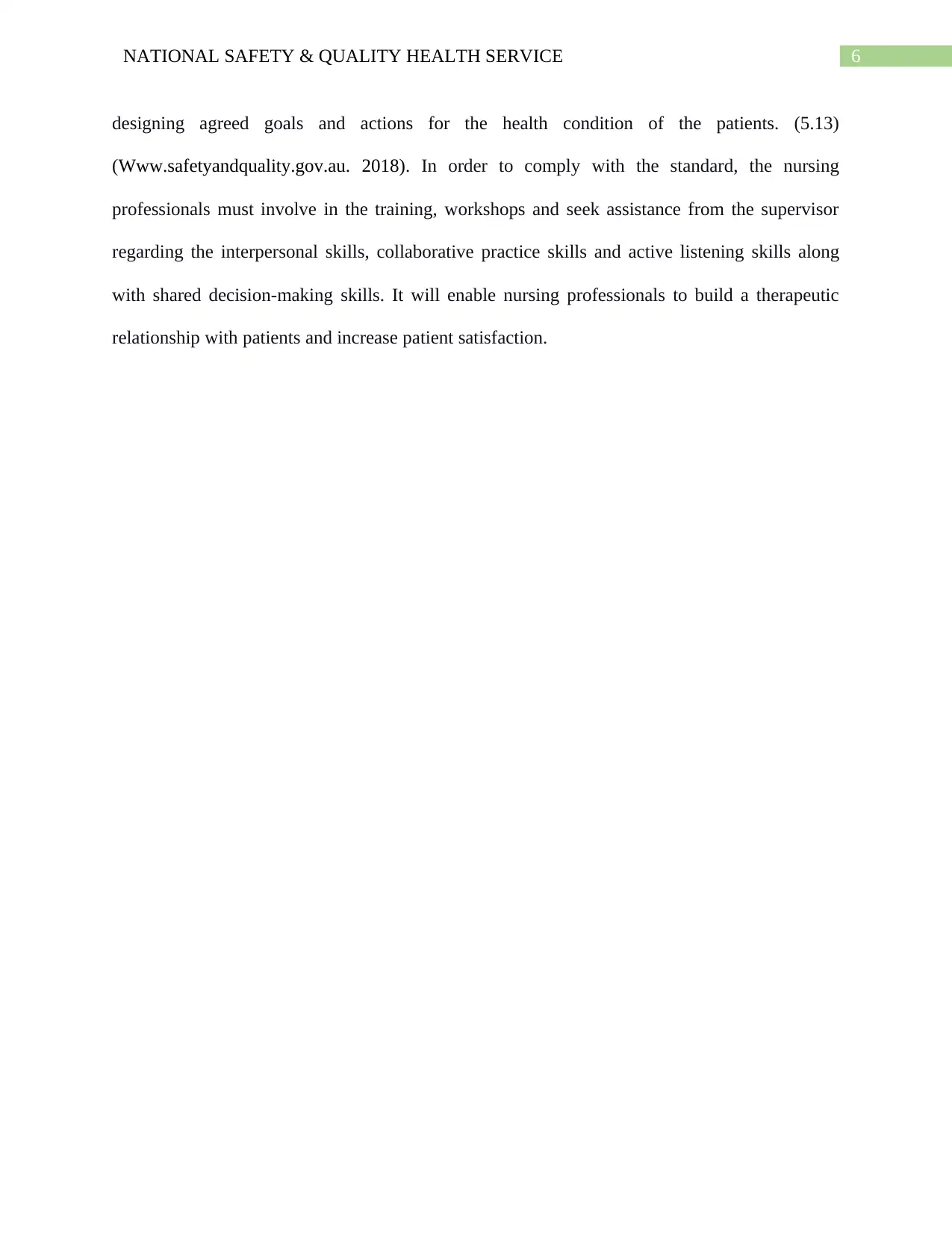
6NATIONAL SAFETY & QUALITY HEALTH SERVICE
designing agreed goals and actions for the health condition of the patients. (5.13)
(Www.safetyandquality.gov.au. 2018). In order to comply with the standard, the nursing
professionals must involve in the training, workshops and seek assistance from the supervisor
regarding the interpersonal skills, collaborative practice skills and active listening skills along
with shared decision-making skills. It will enable nursing professionals to build a therapeutic
relationship with patients and increase patient satisfaction.
designing agreed goals and actions for the health condition of the patients. (5.13)
(Www.safetyandquality.gov.au. 2018). In order to comply with the standard, the nursing
professionals must involve in the training, workshops and seek assistance from the supervisor
regarding the interpersonal skills, collaborative practice skills and active listening skills along
with shared decision-making skills. It will enable nursing professionals to build a therapeutic
relationship with patients and increase patient satisfaction.
Paraphrase This Document
Need a fresh take? Get an instant paraphrase of this document with our AI Paraphraser
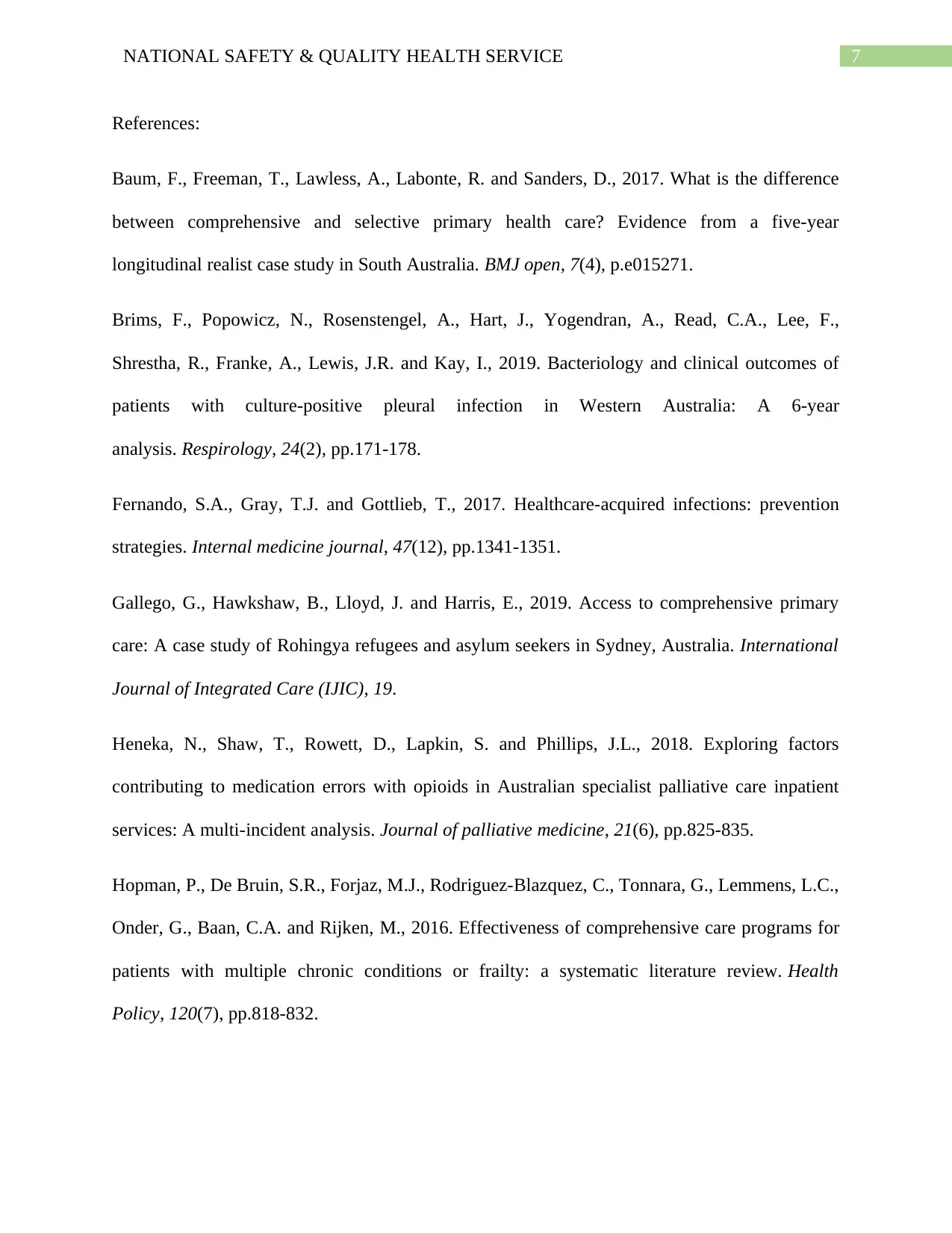
7NATIONAL SAFETY & QUALITY HEALTH SERVICE
References:
Baum, F., Freeman, T., Lawless, A., Labonte, R. and Sanders, D., 2017. What is the difference
between comprehensive and selective primary health care? Evidence from a five-year
longitudinal realist case study in South Australia. BMJ open, 7(4), p.e015271.
Brims, F., Popowicz, N., Rosenstengel, A., Hart, J., Yogendran, A., Read, C.A., Lee, F.,
Shrestha, R., Franke, A., Lewis, J.R. and Kay, I., 2019. Bacteriology and clinical outcomes of
patients with culture‐positive pleural infection in Western Australia: A 6‐year
analysis. Respirology, 24(2), pp.171-178.
Fernando, S.A., Gray, T.J. and Gottlieb, T., 2017. Healthcare‐acquired infections: prevention
strategies. Internal medicine journal, 47(12), pp.1341-1351.
Gallego, G., Hawkshaw, B., Lloyd, J. and Harris, E., 2019. Access to comprehensive primary
care: A case study of Rohingya refugees and asylum seekers in Sydney, Australia. International
Journal of Integrated Care (IJIC), 19.
Heneka, N., Shaw, T., Rowett, D., Lapkin, S. and Phillips, J.L., 2018. Exploring factors
contributing to medication errors with opioids in Australian specialist palliative care inpatient
services: A multi-incident analysis. Journal of palliative medicine, 21(6), pp.825-835.
Hopman, P., De Bruin, S.R., Forjaz, M.J., Rodriguez-Blazquez, C., Tonnara, G., Lemmens, L.C.,
Onder, G., Baan, C.A. and Rijken, M., 2016. Effectiveness of comprehensive care programs for
patients with multiple chronic conditions or frailty: a systematic literature review. Health
Policy, 120(7), pp.818-832.
References:
Baum, F., Freeman, T., Lawless, A., Labonte, R. and Sanders, D., 2017. What is the difference
between comprehensive and selective primary health care? Evidence from a five-year
longitudinal realist case study in South Australia. BMJ open, 7(4), p.e015271.
Brims, F., Popowicz, N., Rosenstengel, A., Hart, J., Yogendran, A., Read, C.A., Lee, F.,
Shrestha, R., Franke, A., Lewis, J.R. and Kay, I., 2019. Bacteriology and clinical outcomes of
patients with culture‐positive pleural infection in Western Australia: A 6‐year
analysis. Respirology, 24(2), pp.171-178.
Fernando, S.A., Gray, T.J. and Gottlieb, T., 2017. Healthcare‐acquired infections: prevention
strategies. Internal medicine journal, 47(12), pp.1341-1351.
Gallego, G., Hawkshaw, B., Lloyd, J. and Harris, E., 2019. Access to comprehensive primary
care: A case study of Rohingya refugees and asylum seekers in Sydney, Australia. International
Journal of Integrated Care (IJIC), 19.
Heneka, N., Shaw, T., Rowett, D., Lapkin, S. and Phillips, J.L., 2018. Exploring factors
contributing to medication errors with opioids in Australian specialist palliative care inpatient
services: A multi-incident analysis. Journal of palliative medicine, 21(6), pp.825-835.
Hopman, P., De Bruin, S.R., Forjaz, M.J., Rodriguez-Blazquez, C., Tonnara, G., Lemmens, L.C.,
Onder, G., Baan, C.A. and Rijken, M., 2016. Effectiveness of comprehensive care programs for
patients with multiple chronic conditions or frailty: a systematic literature review. Health
Policy, 120(7), pp.818-832.
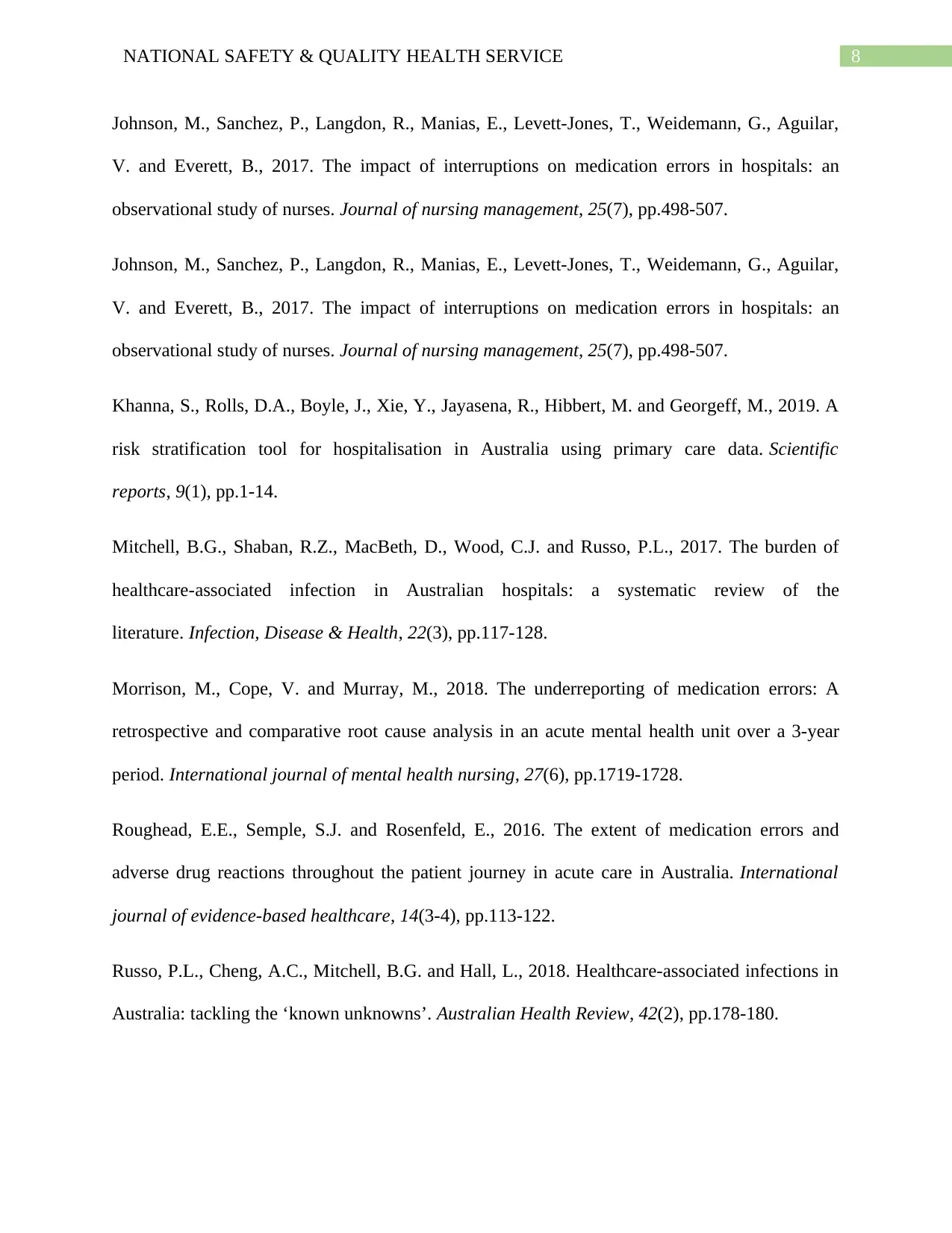
8NATIONAL SAFETY & QUALITY HEALTH SERVICE
Johnson, M., Sanchez, P., Langdon, R., Manias, E., Levett‐Jones, T., Weidemann, G., Aguilar,
V. and Everett, B., 2017. The impact of interruptions on medication errors in hospitals: an
observational study of nurses. Journal of nursing management, 25(7), pp.498-507.
Johnson, M., Sanchez, P., Langdon, R., Manias, E., Levett‐Jones, T., Weidemann, G., Aguilar,
V. and Everett, B., 2017. The impact of interruptions on medication errors in hospitals: an
observational study of nurses. Journal of nursing management, 25(7), pp.498-507.
Khanna, S., Rolls, D.A., Boyle, J., Xie, Y., Jayasena, R., Hibbert, M. and Georgeff, M., 2019. A
risk stratification tool for hospitalisation in Australia using primary care data. Scientific
reports, 9(1), pp.1-14.
Mitchell, B.G., Shaban, R.Z., MacBeth, D., Wood, C.J. and Russo, P.L., 2017. The burden of
healthcare-associated infection in Australian hospitals: a systematic review of the
literature. Infection, Disease & Health, 22(3), pp.117-128.
Morrison, M., Cope, V. and Murray, M., 2018. The underreporting of medication errors: A
retrospective and comparative root cause analysis in an acute mental health unit over a 3‐year
period. International journal of mental health nursing, 27(6), pp.1719-1728.
Roughead, E.E., Semple, S.J. and Rosenfeld, E., 2016. The extent of medication errors and
adverse drug reactions throughout the patient journey in acute care in Australia. International
journal of evidence-based healthcare, 14(3-4), pp.113-122.
Russo, P.L., Cheng, A.C., Mitchell, B.G. and Hall, L., 2018. Healthcare-associated infections in
Australia: tackling the ‘known unknowns’. Australian Health Review, 42(2), pp.178-180.
Johnson, M., Sanchez, P., Langdon, R., Manias, E., Levett‐Jones, T., Weidemann, G., Aguilar,
V. and Everett, B., 2017. The impact of interruptions on medication errors in hospitals: an
observational study of nurses. Journal of nursing management, 25(7), pp.498-507.
Johnson, M., Sanchez, P., Langdon, R., Manias, E., Levett‐Jones, T., Weidemann, G., Aguilar,
V. and Everett, B., 2017. The impact of interruptions on medication errors in hospitals: an
observational study of nurses. Journal of nursing management, 25(7), pp.498-507.
Khanna, S., Rolls, D.A., Boyle, J., Xie, Y., Jayasena, R., Hibbert, M. and Georgeff, M., 2019. A
risk stratification tool for hospitalisation in Australia using primary care data. Scientific
reports, 9(1), pp.1-14.
Mitchell, B.G., Shaban, R.Z., MacBeth, D., Wood, C.J. and Russo, P.L., 2017. The burden of
healthcare-associated infection in Australian hospitals: a systematic review of the
literature. Infection, Disease & Health, 22(3), pp.117-128.
Morrison, M., Cope, V. and Murray, M., 2018. The underreporting of medication errors: A
retrospective and comparative root cause analysis in an acute mental health unit over a 3‐year
period. International journal of mental health nursing, 27(6), pp.1719-1728.
Roughead, E.E., Semple, S.J. and Rosenfeld, E., 2016. The extent of medication errors and
adverse drug reactions throughout the patient journey in acute care in Australia. International
journal of evidence-based healthcare, 14(3-4), pp.113-122.
Russo, P.L., Cheng, A.C., Mitchell, B.G. and Hall, L., 2018. Healthcare-associated infections in
Australia: tackling the ‘known unknowns’. Australian Health Review, 42(2), pp.178-180.
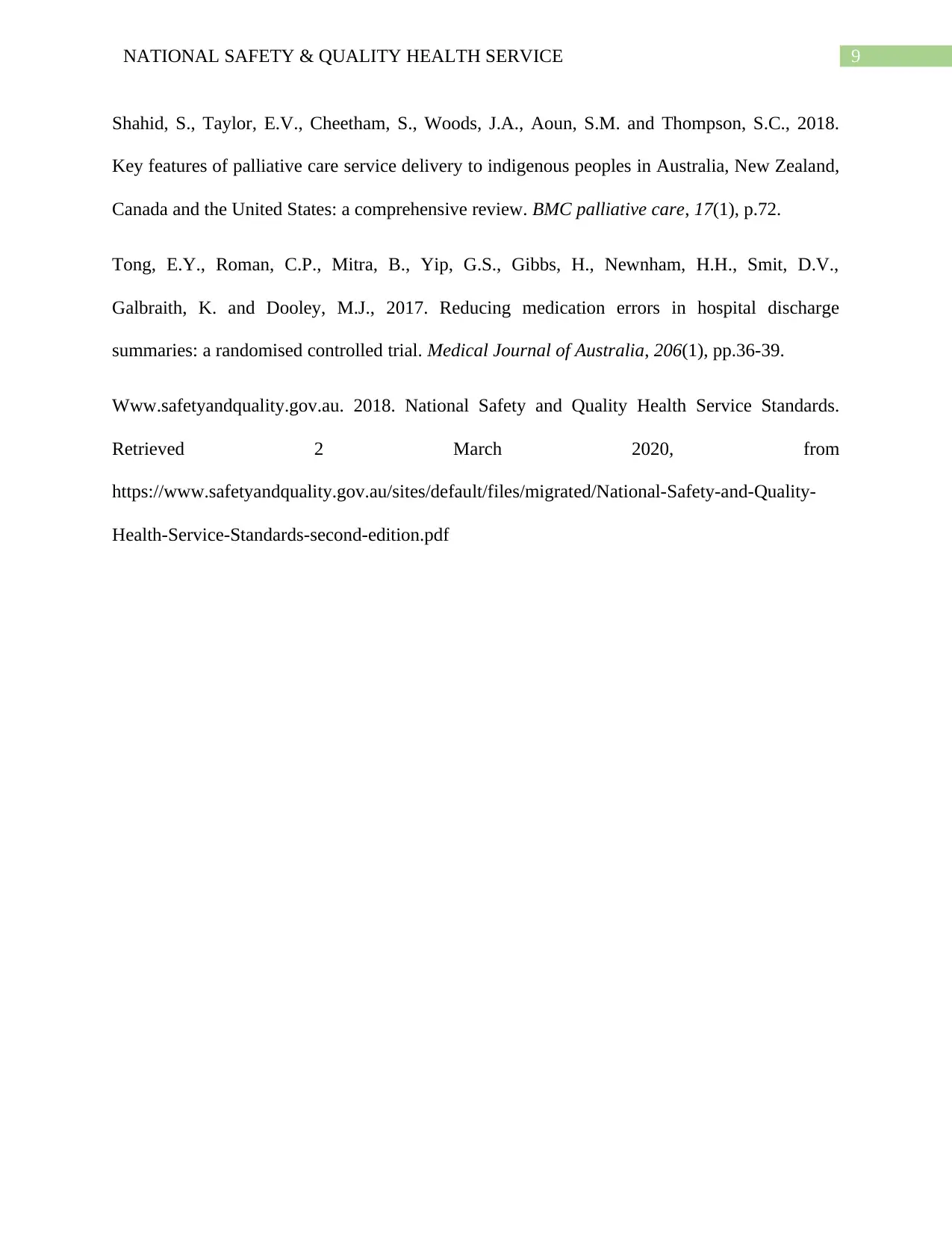
9NATIONAL SAFETY & QUALITY HEALTH SERVICE
Shahid, S., Taylor, E.V., Cheetham, S., Woods, J.A., Aoun, S.M. and Thompson, S.C., 2018.
Key features of palliative care service delivery to indigenous peoples in Australia, New Zealand,
Canada and the United States: a comprehensive review. BMC palliative care, 17(1), p.72.
Tong, E.Y., Roman, C.P., Mitra, B., Yip, G.S., Gibbs, H., Newnham, H.H., Smit, D.V.,
Galbraith, K. and Dooley, M.J., 2017. Reducing medication errors in hospital discharge
summaries: a randomised controlled trial. Medical Journal of Australia, 206(1), pp.36-39.
Www.safetyandquality.gov.au. 2018. National Safety and Quality Health Service Standards.
Retrieved 2 March 2020, from
https://www.safetyandquality.gov.au/sites/default/files/migrated/National-Safety-and-Quality-
Health-Service-Standards-second-edition.pdf
Shahid, S., Taylor, E.V., Cheetham, S., Woods, J.A., Aoun, S.M. and Thompson, S.C., 2018.
Key features of palliative care service delivery to indigenous peoples in Australia, New Zealand,
Canada and the United States: a comprehensive review. BMC palliative care, 17(1), p.72.
Tong, E.Y., Roman, C.P., Mitra, B., Yip, G.S., Gibbs, H., Newnham, H.H., Smit, D.V.,
Galbraith, K. and Dooley, M.J., 2017. Reducing medication errors in hospital discharge
summaries: a randomised controlled trial. Medical Journal of Australia, 206(1), pp.36-39.
Www.safetyandquality.gov.au. 2018. National Safety and Quality Health Service Standards.
Retrieved 2 March 2020, from
https://www.safetyandquality.gov.au/sites/default/files/migrated/National-Safety-and-Quality-
Health-Service-Standards-second-edition.pdf
1 out of 10
Related Documents
Your All-in-One AI-Powered Toolkit for Academic Success.
+13062052269
info@desklib.com
Available 24*7 on WhatsApp / Email
![[object Object]](/_next/static/media/star-bottom.7253800d.svg)
Unlock your academic potential
© 2024 | Zucol Services PVT LTD | All rights reserved.





